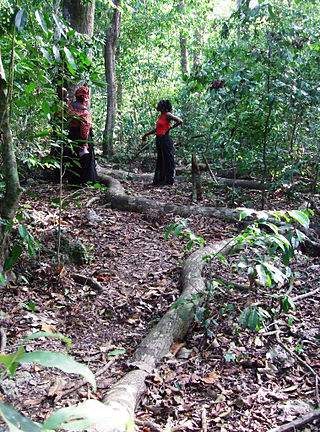Related Research Articles

Mijikenda are a group of nine related Bantu ethnic groups inhabiting the coast of Kenya, between the Sabaki and the Umba rivers, in an area stretching from the border with Tanzania in the south to the border near Somalia in the north. Archaeologist Chapuruka Kusimba contends that the Mijikenda formerly resided in coastal cities, but later settled in Kenya's hinterlands to avoid submission to dominant Portuguese forces that were then in control. Historically, these Mijikenda ethnic groups have been called the Nyika or Nika by outsiders. It is a derogatory term meaning "bush people."

The Giriama are one of the nine ethnic groups that make up the Mijikenda.
The Rombo language, or Kirombo, is a Bantu language of Tanzania spoken by the Rombos in the area of the Kilimanjaro region. Rombo forms a dialect differ with other Chaga languages.
Nyanga-li (Linyanga-le) is a Bantu language in Orientale Province, Democratic Republic of the Congo. Gbati-ri (Gbote) is a dialect. Maho (2009) lists them separately as unclassified Zone D.30 languages, but Ethnologue states that they are "members of the same dialect subgroup", and Glottolog places them nearest the Ngendan languages.
Digo (Chidigo) is a Bantu language spoken primarily along the East African coast between Mombasa and Tanga by the Digo people of Kenya and Tanzania. The ethnic Digo population has been estimated at around 360,000, the majority of whom are presumably speakers of the language. All adult speakers of Digo are bilingual in Swahili, East Africa's lingua franca. The two languages are closely related, and Digo also has much vocabulary borrowed from neighbouring Swahili dialects.
The Sabaki languages are the Bantu languages of the Swahili Coast, named for the Sabaki River. Sabaki is a Pokomo word for Large Fish. In addition to Swahili, Sabaki languages include Ilwana (Malakote) and Pokomo on the Tana River in Kenya, Mijikenda, spoken on the Kenyan coast; Comorian, in the Comoro Islands; and Mwani, spoken in northern Mozambique. In Guthrie's geographic classification, Swahili is in Bantu zone G, whereas the other Sabaki languages are in zone E70, commonly under the name Nyika.
Chuwabo (Echuwabo), also spelled Cuabo and Txuwabo, is a Bantu language spoken along the central coast of Mozambique.
Chopi,, is a Bantu language spoken along the southern coast of Mozambique.
Zemba or Dhimba is a Bantu language spoken mainly in Angola where the language has about 18,000 speakers, and also in Namibia with some 7,000. It is closely related to Herero, and is often considered a dialect of that language, especially as the Zemba are ethnically Herero.
Lala-Bisa is a Bantu language of Zambia that is closely related to Bemba.
Chonyi is a Bantu language spoken along the eastern coast of Kenya in Kilifi County by the Chonyi people. It is part of the Mijikenda dialect cluster.
Taita is a Bantu language spoken in the Taita Hills of Kenya. It is closely related to the Chaga languages of Kenya and Tanzania. The Saghala variety is distinct enough to be considered a language separate from the Daw'ida and Kasigau dialects.
Central Teke is a member of the Teke languages dialect continuum of the Congolese plateau. Central Teke dialects are Ngungwel and Mpu (Mpumpum), Boo, and Nzikou (Njyunjyu/Ndzindziu). They are spoken in the Malebo Pool region of the Republic of Congo, with an unknown number of Boo speakers in DRC.
Tsong or Nsong is a Bantu language of the Democratic Republic of the Congo. It was once misclassified as a dialect of Yansi.
Boma is a Bantu language of the Democratic Republic of the Congo.
Ilwana (Kiwilwana), or Malakote, is a minor Bantu language of Kenya.
The Waata, or Sanye, are an Oromo-speaking people of Kenya and former hunter-gatherers. They share the name Sanye with the neighboring Dahalo.
Losengo (Lusengo) is a Bantu language spoken in the Democratic Republic of the Congo. It has had a significant effect on Lingala, the most important Bantu language in the two Congos.
Shanjo (Sanjo) is a Bantu language of Zambia. Maho (2009) lists it as distinct from Tonga, which it has sometimes been classified as a dialect of.

A kaya is a sacred site of the Mijikenda people in the former Coast Province of Kenya. Often located within sacred forests, a kaya is considered to be an intrinsic source of ritual power and the origin of cultural identity; it is also a place of prayer for members of the Mijikenda ethnic group. The settlement, ritual centre, and fortified enclosure associated with the forest are also part of the kaya. In the present day, the kaya is also referred to as a traditional organizational unit of the Mijikenda. Eleven of the approximately 60 separate makaya have been grouped together and inscribed as the Sacred Mijikenda Kaya Forests, a UNESCO World Heritage Site.
References
- ↑ Chonyi at Ethnologue (26th ed., 2023)

Digo at Ethnologue (26th ed., 2023)
Duruma at Ethnologue (26th ed., 2023)
Giryama at Ethnologue (26th ed., 2023)
Segeju at Ethnologue (26th ed., 2023)
- ↑ Jouni Filip Maho, 2009. New Updated Guthrie List Online
- 1 2 Heine, Bernd; Möhlig, Wilhelm J.G. (1980). Language and Dialect Atlas of Kenya vol 1. Berlin: Dietrich Reimer Verlag. pp. 17–22. ISBN 3-496-00144-5.
- ↑ Maho, Jouni Filip. "New Updated Guthrie List" (PDF).
- ↑ "Ethnologue".
- Walsh, M.T. (2006). "A Click in Digo and its Historical Interpretation", Azania, 41.